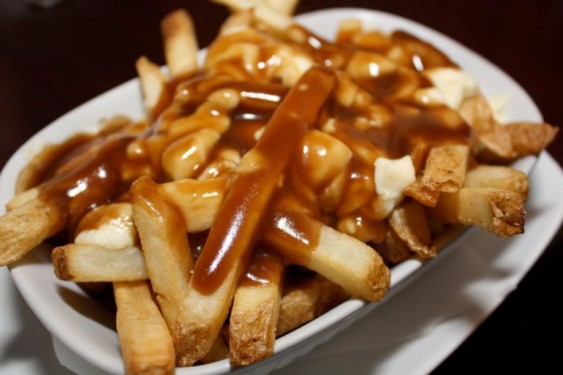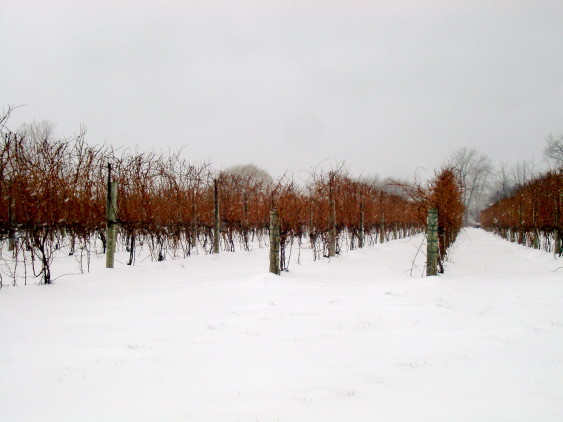In the U.S., today might be Columbus Day, but in Canada, it’s Canadian Thanksgiving! What is Canadian Thanksgiving, you might ask? It’s basically American Thanksgiving, but you might find poutine on the table instead of mashed potatoes.
So in honor of Canada’s national holiday, I wanted to talk about the Canadian wine industry and some pairings you should try if you decide to have an impromptu Canadian Thanksgiving feast this evening.
It might surprise you to know that Canada even has a wine industry, but it has been around since the 1860s, when vines were first planted to make sacramental wines. Though it’s still not too large, Canada’s wine industry is about the 16th in the world in terms of production and generates around $7 billion (CAD) in revenue per year according to the latest account from Wines of Canada.

Look no further than Canada’s wine regions for a wine to pair with poutine. Photo source: Bakesforbreastcancer.
Ontario is the country’s biggest producer, followed by British Columbia, Quebec and Nova Scotia, and finally New Brunswick and Prince Edward Island (for all you Anne of Green Gables fans) making a mere fraction of Canada’s grape-based wines.
You will recognize some of the dominant varieties here, including Chardonnay, Riesling and Viognier, as well as lesser-known ones such as Vidal (which is used in the country’s famous ice wines) on the white side of the spectrum; and Cabernet Franc, Merlot and Pinot Noir, which is pretty much the belle of the ball in terms of reds. Unlike some U.S. versions, the wines made in Canada tend to be more cool-climate, stylistically speaking. That generally means a bit less fruity to the taste, with more acidity, dryness and finesse.
For now, let’s concentrate on the two most important of Canada’s wine regions, the Okanagan Valley in British Columbia, and Ontario’s Niagara Peninsula. Though B.C. has more wineries (around 300), Ontario actually produces a lot more wine – about half of all the wine in Canada, actually.

Try the famous ice wines from Ontario’s Niagara Peninsula. Photo credit: Daniel Hatfield.
Let’s start with the Okanagan. It’s among the world’s northernmost wine regions at around 50 degrees north. Its cool climate is mitigated by plenty of sunshine, dry days, and the tempering influence of the nearby Pacific Ocean. The wines here are reminiscent of those made in famous European wine regions including Germany’s Mosel and France’s Burgundy. Accordingly, look out for Rieslings and Pinot Noirs you come across from the Okanagan.
Though Ontario’s major wine regions, including the Niagara Peninsula, are farther south, the winters here are much colder, and the province has become known for the quality of the ice wines produced there. Ice wines here are made from Vidal or Riesling. Winemakers allow the grapes to freeze naturally on the vine (rather than freezing them in industrial refrigerators), pick them by hand and then press the grapes, separating the juice from the ice. By doing so, there is just a fraction of the juice you would get from non-frozen grapes (about one-fifth), and much higher concentrations of sugar and acidity. These wines make excellent accompaniments to desserts, but also to cheese courses and even very heavy, savory dishes…in moderation.
Apart from ice wines, look to Ontario for cool-climate reds that hearken to European regions like the Loire Valley and Beaujolais, including Cabernet Franc and even Gamay. They are fresh and can have spicy or herbaceous flavors, but still a powerful backbone of dark, red-fruit flavors.

Our neighbors to the north know their wine. It’s time you did, too. Photo source: Home West Bar.
Here are three wines you should try along with your Canadian (or American, if you can wait) Thanksgiving that should pair nicely with certain dishes.
2014 Mission Hill Winery Reserve Riesling: This wine comes from one of the Okanagan Valley’s best producers and is both full-bodied yet bracing. It is slightly off-dry, but not what you’d call sweet. Thanks to delicious flavors of citrus and green apple, along with a lovely amount of acidity that will get your mouth watering, I’d enjoy it as an aperitif, or with your small appetizers and finger foods while you prepare the main course.
Blue Mountain Vineyards Pinot Noir: Also from the Okanagan, this wine exhibits what is best and brightest about the region. Though a relative powerhouse in terms of up-front cherry and other red-berry flavors as well as a dash of spice, it is beautifully balanced, smooth and light-bodied in a way that makes it very food-friendly and the perfect accompaniment to a large Thanksgiving meal.
2013 Inniskillin Vidal Ice Wine: Probably the most famous Canadian ice wine producer, Inniskillin is in the heart of the Niagara peninsula and produces some phenomenal versions from its plantations of Vidal this one is redolent of honey, stone fruits such as nectarine and peach, and has a lovely, lingering finish that smacks of caramelized brown sugar. It’ll go great with any strong cheeses you want to serve, but also the mellow, creamy flavors of pumpkin pie.

